You might often find unwanted or unnecessary files and folders on your PC that you would want to get rid of. Deleting these files or folders helps to make an extra space on your PC which is always a good thing. In this post meant beginners, we will show you the different ways to delete files and folders in Windows 11/10, permanently or temporarily, by means of keyboard shortcuts, File Explorer, PowerShell, Command Prompt, specialized software, etc.
How to delete Files and Folders in Windows 11/10
There are various ways by which you can delete Files and Folders, permanently or temporarily, in Windows 11/10:
- Using Context Menu – Right-clicking on the File or Folder
- Using Keyboard Shortcut – Delete key
- Using Keyboard Shortcut – Shift+Delete key
- Drag & Drop to the Recycle Bin
- Using File Explorer Ribbon
- Using PowerShell
- Using Command Prompt
- Using Specialized Software
Let us look at all of them in detail.
1] Using Context Menu – Right-clicking on the File or Folder
Windows 11

When you right-click on any file or folder that you want to carry out a Cut, Copy, Paste, Rename, Delete, Share, you will now no longer see any options mentioned in text. What you will instead see are icons displayed on the top (or bottom) of the context menu as shown in the image above. These icons stand for:
- Cut
- Copy
- Rename
- Paste
- Share
- Delete.
You have to click on the Bin icon to delete the file or folder..
Windows 10

To delete using the Context Menu, select the file(s) or the folder(s) you wish to get rid of. Right-click on it and press the ‘Delete’ option from the pop-up window that opens. The selected items are sent to the Recycle Bin as they are temporarily deleted and can be recovered if required.
Deleting a folder consisting of other files or folders will delete all that is inside that folder, so make sure you check properly before doing so.
2] Using Keyboard Shortcut – Delete key
While you are on your Desktop or File Explorer, select the items you want to delete and press the ‘Delete’ key or ‘Ctrl+D’ on the keyboard. This will temporarily delete the selected file(s) or folder(s) and will be moved to the Recycle Bin. However, these deleted files can be restored from the Recycle Bin.
To select all files in a folder, select ‘CTRL+A’.
3] Using Keyboard Shortcut – Shift+Delete key
To delete files or folders without sending them to the Recycle Bin, select the items and press ‘Shift+Delete’ on the keyboard. This will permanently delete the selected files. In such a case, these deleted files can only be recovered or restored using specialized software like Recuva.
TIP: Add Permanently Delete to Context Menu to Windows
4] Drag & Drop to Recycle Bin

This is a simple method of deleting the file(s) or folder(s). All you have to do is select the file, and drag and drop it to the Recycle Bin.
5] Using File Explorer Ribbon
This method will teach you how to temporarily or permanently delete file(s) or folder(s) using the Home Menu from the File Explorer Ribbon.
To begin with, open File Explorer (Win+E) and navigate to the location of the files to be deleted. Tap or select the files you wish to get rid of and then.
In Windows 11 click on the BIn icon to delete the file or folder.

In Windows 10, click on the ‘Home’ tab in the Ribbon above.

Further, press ‘Delete’ from the ‘Home’ tab, and you will see that a drop-down menu will open. Press ‘Recycle’ to temporarily delete the file, which will be moved to the Recycle Bin.
To permanently delete the files, select the ‘Permanently delete’ option.

A confirmation dialog box will appear asking if you are sure about permanently deleting this file. Click on ‘Yes’ to proceed.
6] Using PowerShell
If you are unable to delete a file or folder from your computer, you can use Windows PowerShell to delete any file and folder effortlessly. The advantage of using PowerShell is that you can force delete a file and remove all items from inside a folder.
7] Using Command Prompt
You can also delete files & folders using Command Prompt. using the DEL or RD commands.
8] Permanently Delete Files Using Specialized Software
There are specialized software that permanently delete unwanted files from your Windows 10 PC which cannot be recovered by any file recovery tools. Some of these data erasing apps are Eraser, WipeFile, Freeraser, File Shredder, Alternate File Shredder, and more.
You usually have to download and install these apps to use them. These apps permanently delete all the selected files and folders and cannot really be recovered by any specialized recovery tools.
These are all the possible ways to delete File(s) and Folder(s) in Windows 11/10.
Leave a Reply